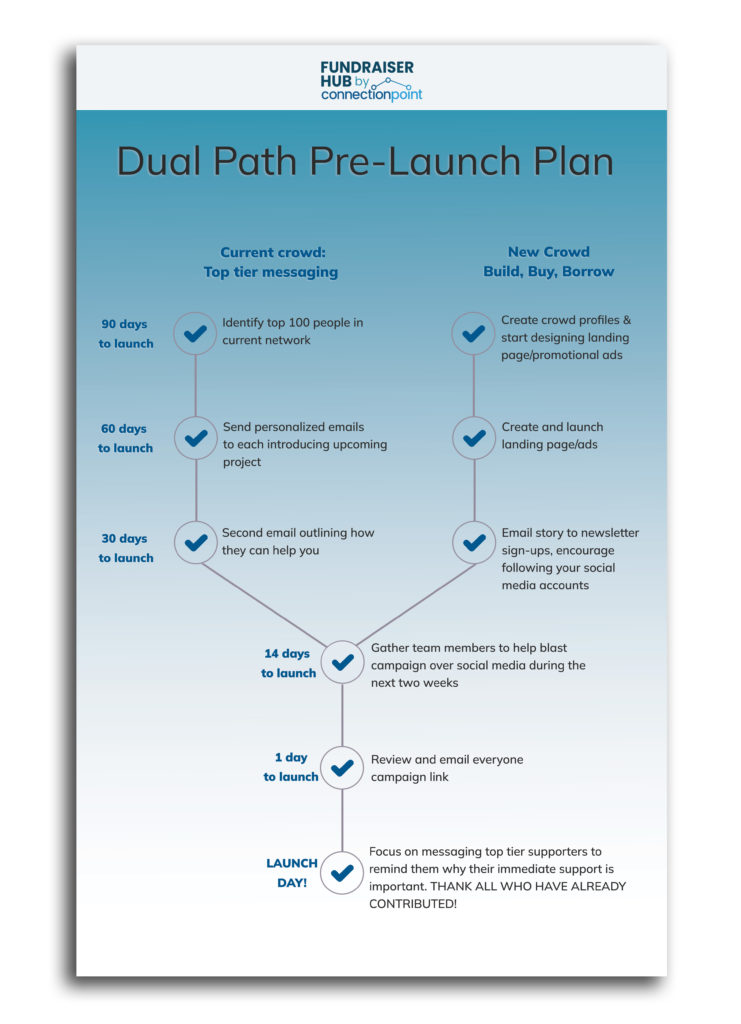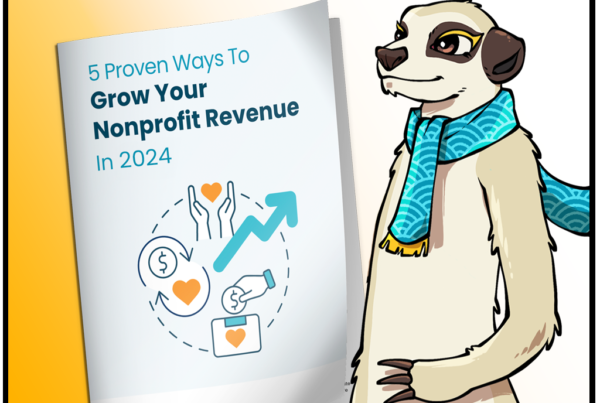A strong pre-launch crowdfunding plan for your campaign could determine your success.
This toolkit will go over the following:
- Determine who your crowd is;
- Creating a pre-launch promotional plan;
- Launch day strategy
- Overcoming the mid-campaign slump
Campaign Promotion Step 1: What is a crowd?
Defining your crowd
| WHO is my crowd? | Every cause will have a demographic it’s most likely to connect with, be it residents of a certain area, people who have used your services (or their friends and families), people who have a specific pet or love for a certain animal, plant, or region, etc. Who is yours? |
| WHAT can I discuss with my crowd? | This is the value you bring. Is it insight into tackling the problem you’re trying to solve? Success stories? Does your crowd understand what makes you and your solution(s) impactful? |
| WHERE is my crowd? | You can find your people in multiple places online: social media and their targeted groups, blogs, forums, and, ideally, your own website and social followers. Also consider in-person avenues: flyers on community boards, to your neighbourhood, at trade shows or conferences, or local establishments willing to help. The campaign QR code is perfect here! |
| HOW can I engage my crowd? | Email, newsletters, forum chats, social media posts, blog comments, etc. Get creative here! Can you provide free information, rewards, an event, etc? |
Campaign Promotion Step 2: The pre-launch promotional plan

Path 1: Current crowd
90 days to launch
Everyone has a current crowd – even if it only consists of friends and family right now. These top 100 are the people you know will want to support this campaign. Their job is to be there as soon as you hit ‘Launch’ to get that thermometer OFF OF 0!
Not everyone can fill this list with 100 people (I sure couldn’t). The more, the better because not everyone will be interested, but 100 is likely the maximum you want.
Why? You are going to be individually messaging all of these people!
60 days to launch
Okay, there are people who are fine to merge into one email (family members, for example). Others should be individually messaged so they understand they are important to you and you choose them to help.
Personalization (“how’s the new puppy doing?”) indicates you aren’t ‘spraying and praying’ for as many contributions as possible. Even blind carbon copying is easy to detect. Doing either of these things negates the whole purpose of this plan.
You likely won’t have your campaign with all its details ready by now, and that’s okay. You are just notifying this group that a campaign is coming, what it will be for, when it will be launched, and (this part is so important it gets its own line and bold font):
What you are hoping they will do for you and WHY!
Explain to them exactly why their early support is important. Their support in the early hours of the first day helps drive you to success.
30 days to launch
Yep, you’re doing it again! Your campaign should be complete by now – at least mostly. If you would like to send the link now for them to subscribe to the campaign, go ahead – subscribing to the campaign means they’ll receive a notice from FundRazr telling them when the campaign is launched. But if you’d like to keep it secret, that’s ok too! We’re just sending a friendly reminder with no action plan right now.
Include whatever you like here – perhaps give teasers about the rewards you’re offering!
Path 2: New crowd
90 days to launch
Now that we have our plan for utilizing the crowd we do have, the next step is building on that crowd. To do that, we have to collect some emails!
The general path we want to take is:
- Attract people with ads and posts
- Direct them to the landing page
- Get them to subscribe to the campaign or a newsletter so we collect their emails.
- Send emails/newsletters leading up to the campaign launch
- Launch the campaign and have them contribute right away!
Again, if you’d like to make things very easy, you can absolutely use your campaign as a “landing page” to collect emails. An outside platform (such as Mailchimp) works much better – but if you don’t have the budget for it or if the free versions don’t give you the functionality you want, FundRazr is there if you need it. The campaign doesn’t have to be launched for people to view – they can see everything, they just cannot contribute yet.
The idea here is the same as with our known crowd: we want people to be prepped and ready to contribute to our campaign once it’s live.
60 days to launch
Plan to have your ads, campaign, and/or landing pages complete (or close to it) around two months pre-launch. This way, you can:
-
- Have a link ready for any random person interested in your project (the teller at my bank asked for mine once!);
- Play around with what works and what doesn’t (for example, does adding picture 1 or picture 2 attract more emails?);
- Have plenty of time to fix anything you may have missed, try new crowds if some just aren’t working, plan newsletters, etc.
30 days to launch
Time for newsletters! While this can be a simple text email, you’re creators! Get creative! Professionalism can do wonders, plus the more visually engaging your newsletters are, the more likely your new followers are to read them. Many email platforms have free versions with lots of template options.
Newsletters should always have a call to action – before your campaign launches, this can be to simply view a social media post (and ‘like’ and save it to boost visibility), or to follow you on your social media so they can become more familiar with you. Familiarity = confidence in your campaign. Or anything else of value.
Converged Path: Final countdown
14 days to launch
- social media posts and responses
- sending emails
- reaching out to influencers and local media to help share
- paid ad management
- answering questions/comments on the campaign
- reward fulfillment (if applicable)
If this is a one-person team, that’s okay! However, consider asking some colleagues/friends/family for help, because not only can they help reduce stress (mental health is important!), but they come with their own crowds!
One day to launch
You’re almost there! You now should have a strong email list of people highly likely to contribute to your campaign. Email them and remind them the campaign launches the next day, and also remind them why it’s important for them to contribute ASAP. Be open and honest here – you are more likely to succeed if this crowd contributes as soon as possible on day one.
You can even see this in our Campaign Success Toolkit – campaigns that receive their first donation on day 1 are 6% more likely to succeed. It’s also widely agreed that campaigns are most likely to succeed if they receive at least 30% of the goal within the first week. Make sure your entire crowd understands that!
LAUNCH DAY!
Woohoo, we’re here!!! Time to roll up your sleeves and dive into email reminders, thanking your donors by commenting right on their contributions in your campaign Activity Feed, answering questions, and ensuring all promotional avenues from your marketing plan are live and working.
And one huge point to remember – ask your supporters to help you further by SHARING! Someone may have only a small amount to donate to your campaign or nothing at all, but they could inspire much, much more through their own communities.
If they’re wondering how to share, direct them to your campaign’s Share Bar!
Campaign Promotion Step 3 – The mid-campaign slump
Campaign promotion continues long after you’ve launched your campaign. It’s common for campaigns to go through a bit of a ‘slump’ after their first week, where little to no contributions are made per day. Combatting this slump involves keeping that ball rolling; don’t let it slow! Maintain your momentum through campaign updates.
Updates provide additional content for you and your supporters to utilize while continually building a foundation of trust and transparency in your organization. What type of content you provide will depend on your campaign, but there is one thing that an update is not: an additional ask for more donations. Updates should be a continuation of the initial story, ideally showing the impact of what funds were already donated. Always provide new and valuable content!
Updates can include:
- Behind-the-scenes pictures/videos
- Progress on projects.
- New rewards (if applicable)
- Mentions in media outlets
- Biographies of organization beneficiaries, workers, or volunteers
- Public posts of your cause in action
- Roadblocks, challenges, setbacks
- Calls for feedback/suggestions for changes, etc.
- Successes, celebrations
- Anything of value or interest!
Not all updates can be planned; however, it’s a good idea to plan ahead and produce content that you can use for your updates sporadically through your promotion. In the workbook below, plan out some potential updates ahead of time (you can even pre-write and schedule them to post ahead of time!).
Workbook
Use this workbook to plan out your campaign promotion strategy.
*Please consider the environment before printing. Try copying and pasting or recreating tables on your own.*
Check out these toolkits next:




